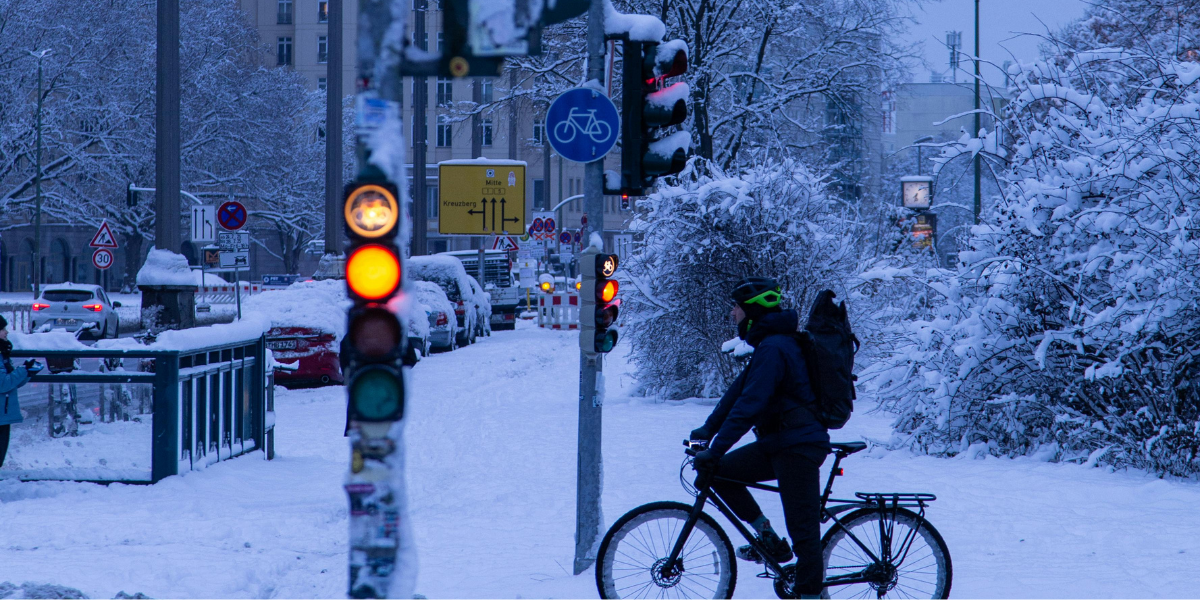Due to current circumstances, a question is frequently asked: Can a bicycle freeze? And if so, what freezes on the bike and what can be done about it? Here is our guide for frozen brakes on bicycles:
There are occasional reports of icy problems with bicycle gears, dampers, or suspension forks. Truly unlucky people find their bike buried under a thick layer of ice and then have to take the bus. It actually happens repeatedly that bicycle brakes freeze – and this becomes very dangerous! Because when water freezes in the Bowden cables, you can't tell by looking at the bicycle that something is wrong. It also rides as usual. During the first braking maneuver, it becomes clear that the stoppers do not respond. Here, frozen bicycle brakes are the focus, and you'll learn how to prevent this problem and how to thaw them if necessary.
It's the stuff horror reels are made of: Someone gets on their bike, bundled up in winter weather, and sets off. And then the shock – at the first red light, they have to brake, and the brake … fails! A crash is inevitable.
Many commuters are surprised in winter by frozen brakes on city bikes, cargo bikes, or trekking bikes . But even on performance bikes, on racing bikes, gravel bikes, or MTBs, the brakes can freeze. No matter what bicycle you ride, it is possible for the brakes to freeze. Here you'll learn how to avoid the frosty surprise and how to free the brake from ice and frost if necessary.
|
Our tip: Please test your brakes and gears in sub-zero temperatures before you set off! Without gears, you can at least stop and dismount. If you only realize that the brake is frozen when you're rolling down a slope or just before an intersection, it's too late! |
Prevention is better – how to prevent your bicycle brakes from freezing
How can you prevent the brakes on your bicycle from freezing? Quite simply, the best solution is, of course, to protect the bicycle from frost!

Fortunately, it is usually not the bicycle brake itself that is frozen. Most often, the brake cable is frozen in the outer casing. Image © Trek
A warm spot prevents frozen brakes on the bicycle
A bicycle cellar, the garage, or the hallway are possible frost-free bicycle parking places. If the bicycle is not supposed to stand around in the apartment all day, it is enough to bring it in at night. The brake lines thaw out overnight, so you can ride to work without worry in the morning. However, the temperature difference should not be too great, cool and frost-free is ideal.
If it is cold during the day, you can perhaps also park your bicycle protected at the workplace. Is there a frost-free underground garage or is the bicycle allowed to stand in the basement of the office building exceptionally? This way, you can come home after your workday without frozen bicycle brakes. At least you can try to park your bicycle wind-protected or in the sun.
Park your bike dry!
You should also protect your bicycle from moisture! Unfortunately, a white, cold winter has become rare in most regions of Germany, temperatures hover around the freezing point; snow, sleet, and rain alternate. If the weather fluctuates between frost and moisture, frozen brakes are a common problem. Moisture especially affects mechanical brakes .
It can therefore help if you park your bicycle under a roof, you can also cover it.
Especially in winter, a bicycle needs to be cleaned from time to time, as grit and salt are poison for the drivetrain, frame, and brakes. After washing, your bicycle should dry well and be lubricated so that everything does not freeze during the next frost.
Don't forget the bicycle check!
A well-maintained bicycle causes less trouble. There are two points that are particularly important here if you don't want to deal with frozen brakes in winter:
- You should not miss the annual bike check. Brake housings wear out, become brittle, or crack. Then moisture has an especially easy time. Moisture can collect in the Bowden cable and freeze at temperatures below 0°C. During the annual bicycle service, a leaking brake housing should be noticed and replaced.
- If your bicycle is well lubricated or oiled , it becomes less susceptible to frost, because water freezes, oil and grease do not. Of course, you shouldn't just oil aimlessly, but if connections and wear parts are well greased, they are better protected from moisture and ice. More on the topic Bicycle Grease can also be found in the Bike Blog.
Is the brake on my bike really frozen?
You want to get on your bike and ride in the morning, but the brake won't move. Is it broken or is it frozen? If your bike has spent the night outside in the cold, it's quite possible that moisture in the brake lines has frozen. Then the brake lever can no longer move the brake caliper.
> Was it particularly cold?
> Did your bike's brake work perfectly shortly before?
> Was the bike perhaps wet before the big cold hit?
Then hopefully nothing is broken, you can thaw the bicycle brake.
But you should also take a close look at your bike. Is the brake undamaged? If the bike has fallen over or some joker has tampered with it, the brake might simply be broken . Maybe new brake pads or a brake service are due, you should check the wear from time to time.
Frozen brake lines on the bike
You have made sure that nothing is damaged or misaligned on your brakes. They are actually frozen. How can this be?
There are different braking systems on bicycles that can present their owners with different problems in winter. In most cases, the brakes themselves do not freeze, rather condensation freezes in the brake line and prevents the brake cable from moving. This problem only occurs with mechanical bicycle brakes , hydraulic brakes are normally frost-proof.
Mechanical bicycle brakes are frozen
In a mechanical bicycle brake a brake cable provides deceleration. In a "brake housing" (= a thin tube) is a wire ("Bowden cable"), which transmits the movements of the brake lever to the brake. Due to material aging and the friction that the cable causes inside the housing, brake housings become leaky over time. Then water can enter and at sub-zero temperatures the brake cable freezes. Also, the connections between the brake cable and the brake lever or between the cable and the brake itself can be leaky.
|
✅ A regular bicycle check provides safety here! During the service, a leaking brake housing should be noticed and replaced. |
|
✅ If your bicycle is always kept dry , the risk of waterlogged brake cables is lower. |
|
✅ There is also the tip to additionally seal the ends of the brake cables to prevent water from entering. This can work well at the upper ends of the cables (at the handlebars), but it becomes more difficult at the lower ends. You must definitely ensure that the function of the brake is not impaired! |

Here you see the cable protruding from the housing. Water in the brake housing can freeze and immobilize the brake cable, and thus the bicycle brake. Image © Title MBT
Can bicycle disc brakes freeze?
Disc brakes come in two different versions – mechanical or hydraulic.
With a mechanical disc brake , the brake cable can freeze.
Hydraulic bicycle brakes are filled with mineral oil or DOT brake fluid. They are a closed system, and where no water can enter, nothing can freeze. So goes the theory. However, there are reports of failing hydraulic brakes because in extreme cold, the rubber seals can harden and make the brakes stiff. In particularly cold temperatures, the pistons may not return to their starting position – and the brake remains engaged. But hydraulic bicycle brakes filled with mineral oil should not freeze. DOT brake fluid can "absorb water," but it needs to be regularly replaced to prevent danger.
Bicycle rim brakes are frozen
Rim brakes are mostly mechanical brakes, where a wire = brake cable in a housing transmits the braking motion. Water in the brake housing can freeze, thus freezing the bicycle brake. You can read below how to thaw the brake in this case.
For rim brakes, you should also consider 2 points in winter:
- The brake pads are made of rubber, which is why they are also called “brake rubbers.” Rubber can harden in cold temperatures, thus changing the braking properties of the bicycle. Start carefully and test the brakes on a flat surface so you know how they react.
- Cold or frost can make the contact surface of the brakes on the side of the rims slippery. Your braking distance will then be longer, which you should also test at the beginning of your ride.
Special Case Cargo Bike
Some cargo bikes or cargobikes have a parking brake. Here, the brake lever of the bike has a button or a lever that keeps the brake engaged permanently. This is very practical because these heavy bikes stand securely and reliably in place. However, you should not engage this parking button or lever during frost, as the permanently engaged brake can not only freeze, here the brake pads freeze solid to the brake disc !
|
✅ In frost, you should not park a cargo bike with the parking brake engaged! |
How to Thaw Frozen Brakes on a Bicycle
There are different tricks to help you if your bicycle brake is frozen. Here are the common solutions:
- The most popular method to get frozen bicycle brakes working again is nothing but hot air – with a hairdryer the shock-frozen brake quickly warms up again. But not too hot and not too close, after all, the casing is made of rubber.
- Often warm water is recommended. But this method should be used with caution. Warm water may temporarily make the frozen brake operable again, but it can only freeze worse afterward due to the moisture! Better than pouring hot water over the frozen bicycle parts is to dip a cloth or towel in warm water and wrap the frozen parts in it.
- Warm water in a bag can help thaw the brake lines piece by piece. You need some patience, but if the hairdryer cord is too short, you should try this method.
- Do you know pocket warmers? If it’s not too cold and there isn’t much liquid frozen in the cables, you can try this.
- If your bicycle brake has been thawed but still contains water, it will freeze again at the next opportunity. Let your bike thaw and dry first, and then leave it for a while in a warm place so the moisture can evaporate from the brake cables. With some luck, it won’t freeze again.
- With hardened sealing rubbers On a cold hydraulic disc brake, warming up and waiting is the safest method.
 Grab the hairdryer, with it you can thaw frozen Bowden cables in the brake lines. Image © Element5 Digital on Unsplash
Grab the hairdryer, with it you can thaw frozen Bowden cables in the brake lines. Image © Element5 Digital on Unsplash
Thaw frozen bicycle brakes with de-icer?
This tip is often spread on the internet: If bicycle brakes are frozen, they can be thawed with door lock de-icer. In any case, you can use de-icer spray to thaw your bike lock. But whether the mixture is suitable for your mechanical brakes is hard to say, because for this type of problem-solving you need to fill the outer casing of the brake line with the mixture. In case of doubt, you should definitely ask a bicycle workshop whether and how you can thaw the brakes on the bike with de-icer fluid.
Safe through the winter with the bicycle
Ensuring well-functioning brakes is the most important component in terms of bicycle safety, and it really doesn't depend on the season. But especially in winter, well-maintained brakes are particularly important. You can also do more to be well-prepared for the adverse weather conditions of winter. Winter tires for the bike are a good start. Here in the Bike Blog, you will find an article that explains the advantages and disadvantages of different bicycle tires .
Additionally, you will find lots of information about
- bicycle clothing for winter
- cleaning & maintaining the bicycle: Keeping it clean in 5 steps through the winter
- Winter with the bicycle – Finally safe through ice and snow
- Bicycle storage in winter
And of course helmet on, then you've done everything for your safety.
Title image: Mohammed Abubakr on Pexels





